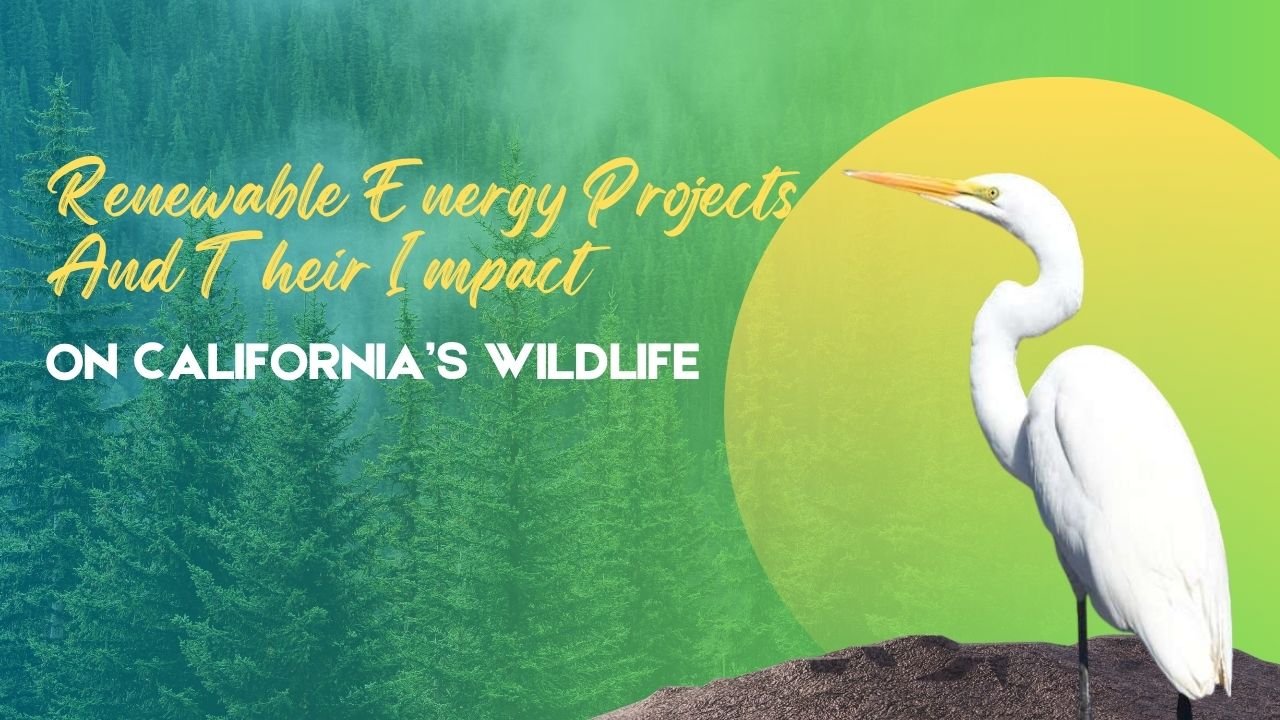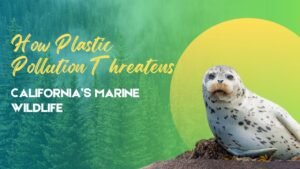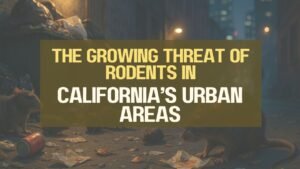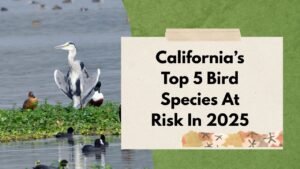California is racing toward 100% clean electricity by 2045, rapidly adding solar, onshore wind, battery storage, and early-stage floating offshore wind.
That build-out is essential for climate goals, yet it overlaps with sensitive California wildlife and habitats—desert tortoises, burrowing owls, bats, eagles, condors, seabirds, and migratory whales.
The state’s approach in 2024–2025 has been clear: plan smart, engineer risk down, and operate adaptively so clean energy expands while wildlife thrives.
California’s Renewables Boom And Why Wildlife Impacts Matter
The clean-energy surge reduces greenhouse gas emissions that drive drought, wildfire, and heat waves—threats that already stress wetlands, rangelands, and coastal ecosystems.
But the locations best for solar insolation and wind resources can also support vulnerable species.
California addresses this by pairing landscape-scale planning with project-level mitigation, ensuring new megawatts arrive with real protections for biodiversity.
Key pillars of the strategy include:
- Prioritizing disturbed or lower-conflict lands (e.g., previously farmed or industrial parcels).
- Avoiding ecological hotspots and wildlife corridors.
- Adaptive monitoring that changes operations if impacts appear higher than expected.
- Compensatory conservation (restoration, habitat purchase, or species-specific programs) when avoidance alone isn’t sufficient.
Solar Projects- Lake-Effect Birds, Desert Species, And Smarter Designs
PV facilities can, in some contexts, create water-like visual cues that attract certain water-associated birds—a phenomenon often called the “lake effect.”
The response is not one-size-fits-all. California developers now pair strategic siting (away from wetlands or key flyways) with engineering solutions such as panel surface treatments and non-reflective materials to reduce polarized glare.
On-site practices like vegetation management, humane hazing, and targeted deterrents further decrease risky interactions.
In desert valleys, large utility-scale solar can overlap with Mojave desert tortoise and burrowing owl habitat. Modern permits include:
- Clearance surveys and exclusion fencing.
- Time-of-year restrictions for ground-disturbing work.
- Passive relocation protocols for burrowing owls if active burrows are found near work areas.
- Translocation plans for tortoises, with health screening, soft-release, and post-release telemetry to track outcomes.
These steps aim to keep construction within compliance while minimizing take and ensuring animals have safe, suitable habitat.
Land-Based Wind- Bats, Eagles, And Condors
Bat conservation is the most consistent focus at wind projects. Evidence from the last decade shows that raising cut-in speeds (the wind speed at which turbines start generating) during peak bat activity can reduce bat fatalities dramatically with modest energy losses.
Many California operators now use seasonal or night-time curtailment, and some layer in acoustic deterrents that make rotor-swept zones less attractive to hoary bats and other migratory species.
For large raptors, projects increasingly use:
- Pre-construction surveys and micro-siting to avoid high-use flight paths.
- Remote cameras, avian radar, and GPS/VHF tracking.
- Geofenced alerts and shutdown-on-demand protocols when golden eagles or California condors approach.
- Compensatory mitigation (e.g., retrofitting power poles to prevent electrocutions) that yields measurable population benefits.
Importantly, collaborative frameworks in wind corridors—pairing project operators with wildlife agencies and conservation groups—have led to rapid, coordinated curtailment when protected species are detected.
Offshore Wind- Early Steps, Big Guardrails For Whales And Seabirds
California’s floating offshore wind leases off Humboldt and Morro Bay are still in early planning.
Because floating platforms use anchors and mooring lines, the state and federal reviews are front-loading wildlife protections:
- Vessel speed limits and seasonal timing windows to reduce whale strike risk.
- Noise management (quieting technologies, soft starts, and monitoring) during construction to protect marine mammals.
- Mooring and cable design to lower entanglement risks.
- Seabird-sensitive layouts and lighting protocols to reduce attraction and collision.
- Comprehensive baseline surveys with long-term monitoring to verify that mitigations work.
Ports like Humboldt Bay are being planned as specialized hubs to stage and assemble floating platforms, centralizing activity and improving oversight.
Siting Done Right- Planning That Reduces Conflict
Where we build is as important as what we build.
In the California desert, long-running planning efforts direct projects to lower-conflict development zones while conserving high-value habitat for tortoises, bighorn sheep, raptors, and rare plants.
Across the state, county and regional plans now encourage:
- Co-location on already-disturbed lands (e.g., alongside transmission corridors, brownfields, and working lands).
- Clustered development near existing substations to limit new linear infrastructure and fragmentation.
- Wildlife corridor mapping so turbines and arrays don’t sever migration routes.
The result is fewer surprises, faster permits, and better outcomes for wildlife.
Co-Benefits- Solar Over Canals And Wildlife-Friendly Co-Location
One of California’s most promising innovations is solar-over-canals. By spanning existing water conveyance canals with solar canopies, utilities can:
- Generate clean electricity without converting intact habitat.
- Reduce evaporation, keeping more water available for people, farms, and ecosystems.
- Suppress aquatic weeds, potentially lowering herbicide use and maintenance costs.
Similarly, agrivoltaics—placing elevated solar above pollinator habitat or grazing—offers a path to produce power while supporting biodiversity.
Managed correctly, native seed mixes, pollinator strips, and wildlife-permeable fencing can turn solar arrays into micro-refuges that stitch fragmented landscapes together.
Quick Reference- Projects, Risks, And What’s Working (2024–2025)
| Project/Topic | Primary Wildlife Concern | What Recent Practice Shows | Mitigation In Practice | Implementation Stage |
|---|---|---|---|---|
| Utility-Scale PV (“Lake Effect”) | Bird attraction to polarized light | Attraction varies by site and species; engineering can reduce cues | Panel surface treatments, non-reflective materials, siting away from wetlands | Incorporated into new designs and retrofits |
| Concentrating Solar (Power-Tower) | Bird injury in flux fields | Monitoring + operations changes reduce risk over time | Heliostat stow patterns, avian monitoring, reporting & adaptive management | Ongoing at operating plants |
| Desert Species Near Solar | Burrowing owl, desert tortoise | Better pre-construction planning reduces take and delays | Clearance surveys, exclusion fencing, owl relocation, tortoise translocation & tracking | Standard in modern permits |
| Onshore Wind & Bats | Hoary bat, other migratory bats | Higher cut-in speeds and smart curtailment sharply cut fatalities | Seasonal/night curtailment, acoustic deterrents, real-time triggers | Widely deployed in bat season |
| Eagles/Condors At Wind | Collision risk | Tech + protocols protect large raptors | Geofencing, GPS alerts, shutdown-on-demand, offset programs | In use at California wind sites |
| Offshore Wind (Floating) | Whales, seabirds, entanglement | Guardrails baked in before construction | Speed limits, noise management, cable/mooring design, lighting rules | Early planning & baseline surveys |
| Solar Over Canals | Habitat conversion (avoided) | Power + water savings + reduced weeds | Canopy PV over canals, minimal new land take | Pilot-to-early deployment |
What This Means For California In 2025
- Better Siting First. Direct large projects to lower-conflict lands and away from key habitats and wildlife corridors to reduce risk and speed approvals.
- Engineer Away Risk. Use PV surface tech, non-reflective materials, and facility layout tweaks to cut bird attraction without sacrificing generation.
- Operate Smarter. For wind, apply seasonal/night curtailment and smart triggers to protect bats with modest energy impacts; keep shutdown-on-demand tools ready for eagles and condors.
- Innovate For Co-Benefits. Scale solar-over-canals and agrivoltaics to generate electricity without converting intact habitat, while creating pollinator-friendly under-story.
- Measure, Then Adapt. Build monitoring into permits, publish results, and course-correct quickly—protecting wildlife and maintaining public trust.
California’s clean-energy build doesn’t have to come at the expense of wildlife.
The state is proving that smart siting, engineering solutions, and adaptive operations can meaningfully reduce risk while bringing new solar, wind, and offshore wind online.
Add in innovations like solar-over-canals and agrivoltaics, and you get a blueprint that cuts emissions, protects biodiversity, and keeps the energy transition moving—all at the same time.
FAQs
Do renewable projects still harm wildlife even with modern mitigations?
Yes, but far less when today’s best practices are used. Siting on disturbed lands, applying engineering fixes at PV sites, and deploying wind curtailment for bats all reduce fatalities and disturbance. When risk remains, shutdown-on-demand and offset programs keep impacts within strict limits.
What about birds at big solar plants—are they always at risk?
Not always. The so-called “lake effect” isn’t universal. The combination of careful siting, non-reflective materials, panel surface treatments, and humane deterrents can significantly lower attraction and collisions, especially when facilities are not near wetlands or major flyways.
Will offshore wind harm whales off California?
The goal is to avoid that through front-loaded protections: vessel speed limits, seasonal work windows, noise controls, wildlife observers, and mooring/cable designs that limit entanglement. Extensive baseline and ongoing monitoring is planned so operations can adapt if issues arise.



